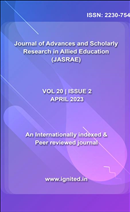Physical Characterization of a Watershed through Geographic information system
A comprehensive approach to analyzing and managing watersheds using remote sensing and GIS
Keywords:
remote sensing, geoprocessing, watershed, drainage basins, morphometric analysis, GIS, image processing techniques, land use, occupation, soil science, geology, climatology, physical characteristics, environmental management, water resources management, scenario modeling, predictionAbstract
Remote sensing and geoprocessing play a crucial role in acquiring and preserving datapertaining to human activities in spatial domains across time. These techniques serve as the foundationfor assessing land utilization, environmental disruptions, and regional advancements. An area of land thatpermits surface runoff to enter a specific drainage, stream, river, or channel at a certain location is called awatershed. The fundamental component of the water supply that changes throughout time is this. When itcomes to drainage basins or a specific type of landform, morphometric analysis is a quantitativedescription and analysis of landforms used in geomorphology. The water resources management andplanning process has found that the Geographic Information System (GIS) and Remote Sensing (RS) areeffective tools for defining drainage patterns. For the purpose of identifying morphological features andexamining their attributes within the watershed, the current study has utilized GIS and image processingtechniques. Remote sensing and geoprocessing are fundamental methodologies utilized to acquire andpreserve logs of human activities in space throughout history. These methodologies provide thefoundation for identifying and diagnosing issues related to land use, environmental interference, andlocal development. The purpose of this article is to establish a foundation for a tool that facilitates theintegrated environmental management of watersheds by identifying physical characteristics of thewatershed, including land use and occupation, soil science, geology, climatology, and the extent andlocation of the watershed, among others. In order to facilitate the integrated environmental managementof the watershed, its physical characteristics were determined through the use of climatological datafrom the watershed, field visits, a review of relevant literature and journals, and the application ofgeographic information systems (GIS) to obtain pedological and geological maps, as well as land useand occupation maps. GIS was integrated with the process of obtaining these data. It is imperative toperform an environmental assessment within this catchment in order to effectively manage the land andenvironment. Nevertheless, these evaluations fail to cover all watersheds, and even when they do occur,their frequency is inadequate to enable ongoing monitoring that would facilitate scenario modeling andprediction in order to formulate intermediate and long-term environmental protection measures.Published
2023-04-08
How to Cite
[1]
“Physical Characterization of a Watershed through Geographic information system: A comprehensive approach to analyzing and managing watersheds using remote sensing and GIS”, JASRAE, vol. 20, no. 2, pp. 520–525, Apr. 2023, Accessed: Dec. 25, 2025. [Online]. Available: https://ignited.in/index.php/jasrae/article/view/14424
Issue
Section
Articles
How to Cite
[1]
“Physical Characterization of a Watershed through Geographic information system: A comprehensive approach to analyzing and managing watersheds using remote sensing and GIS”, JASRAE, vol. 20, no. 2, pp. 520–525, Apr. 2023, Accessed: Dec. 25, 2025. [Online]. Available: https://ignited.in/index.php/jasrae/article/view/14424











